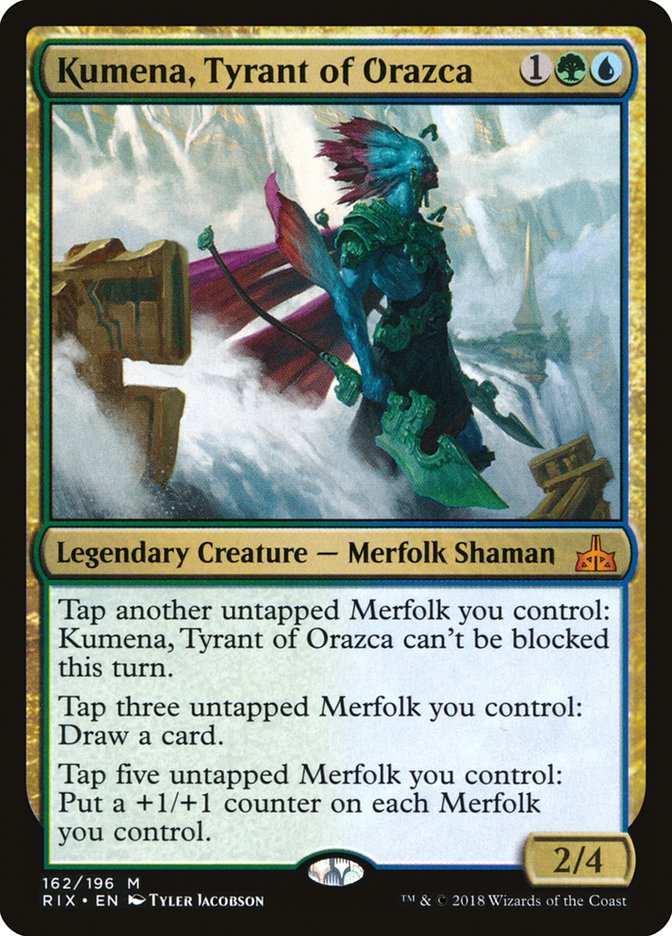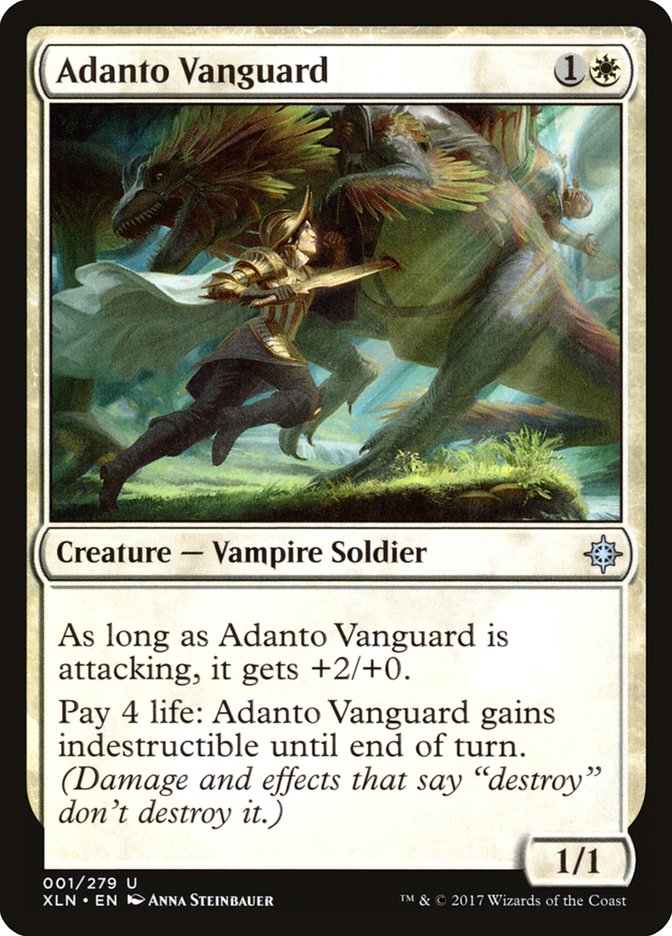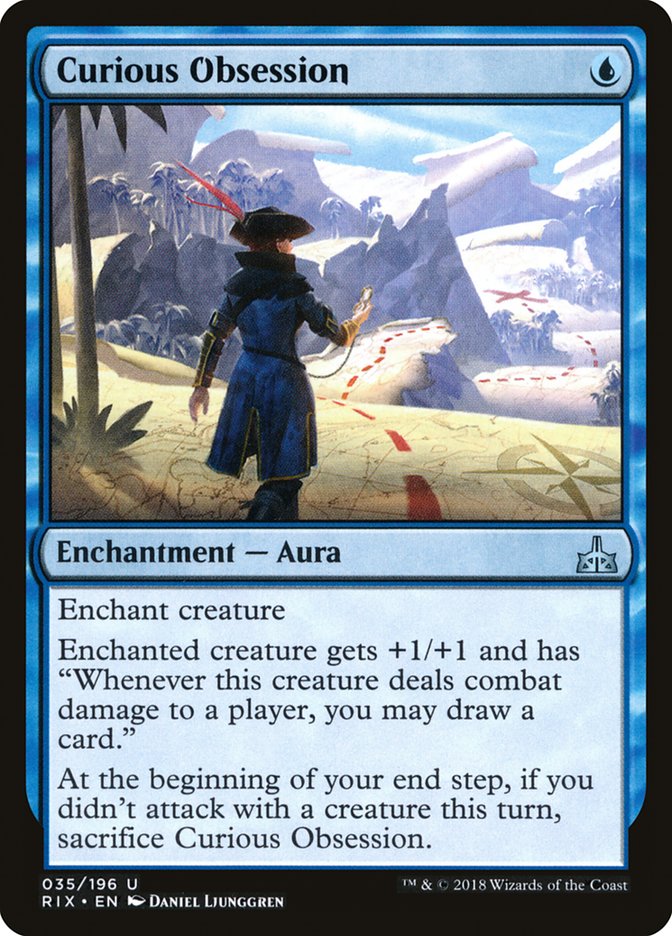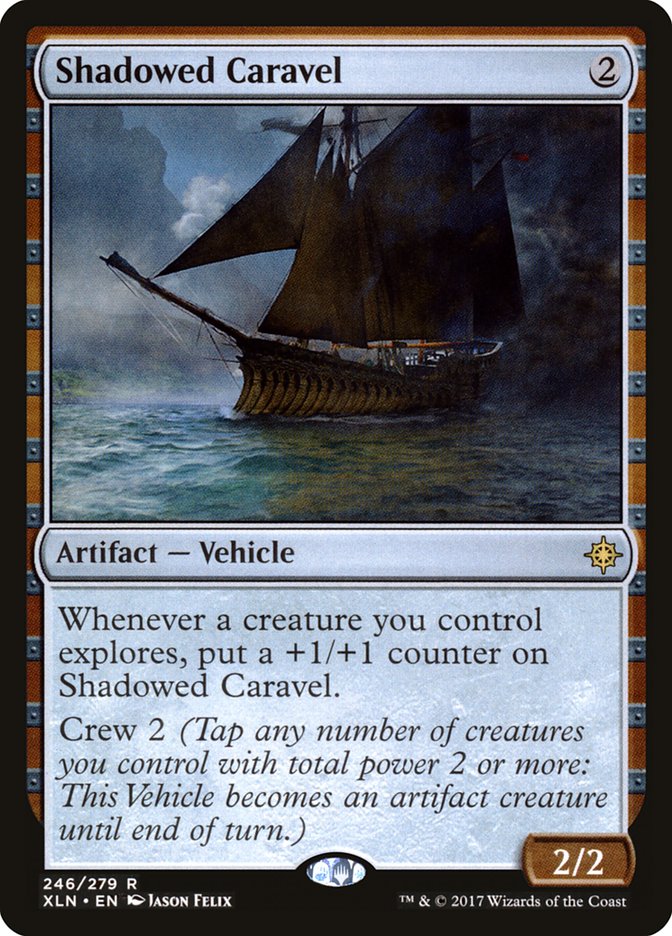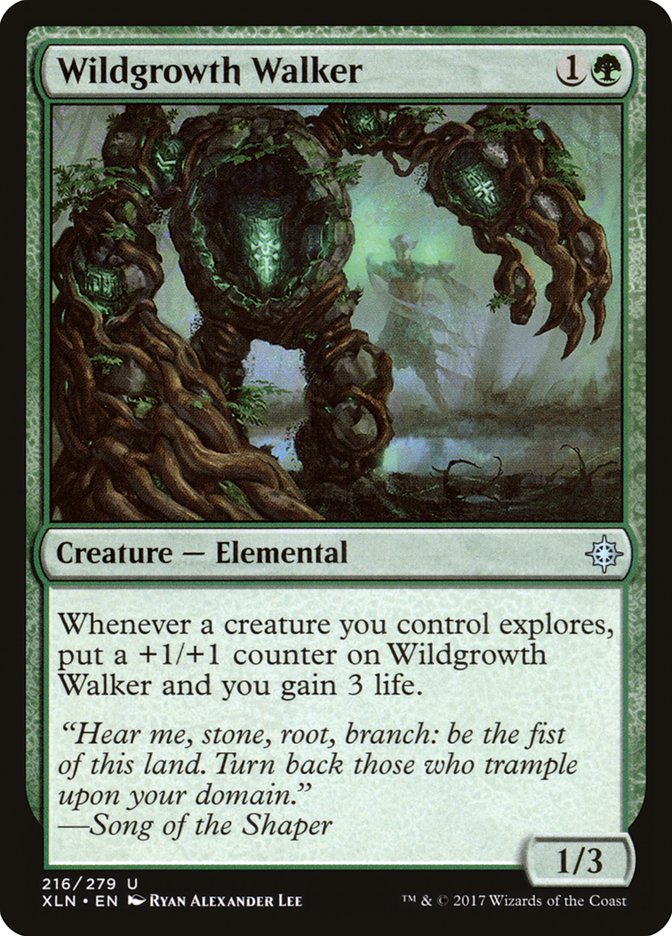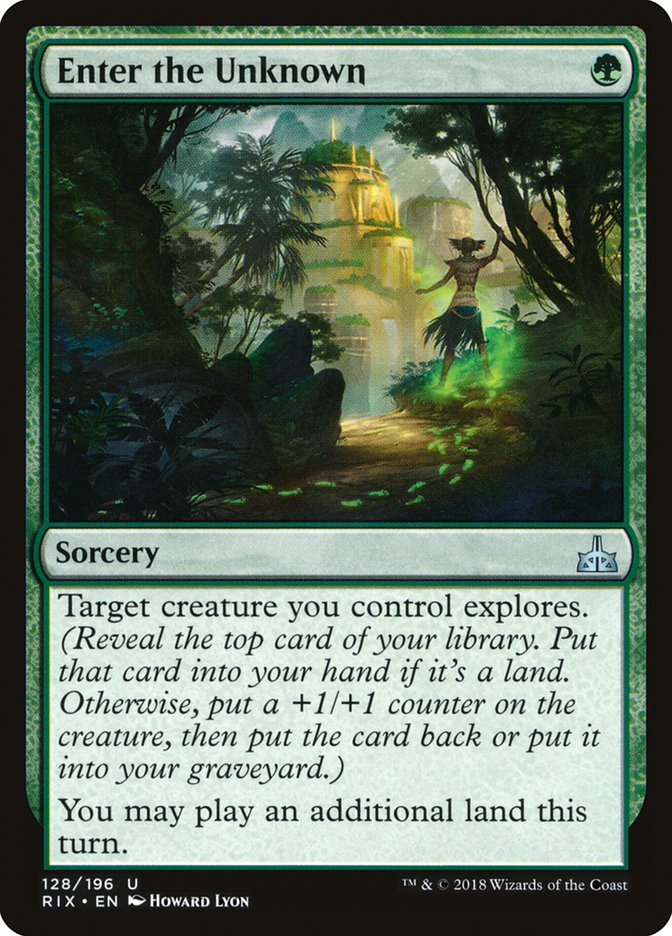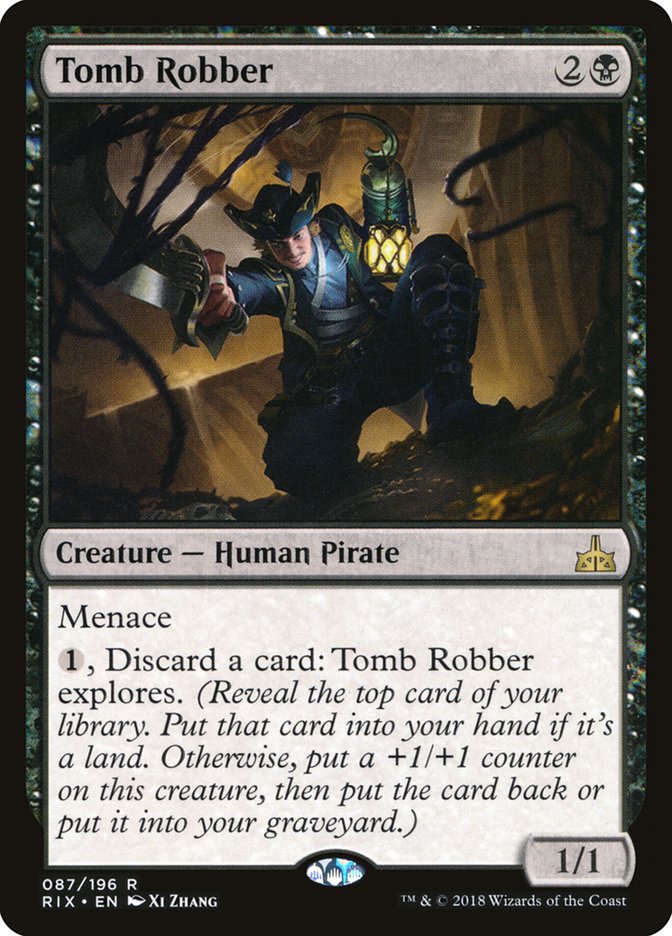Between the bans and a new set, we’re expecting to see some decks in
Standard we haven’t seen before to contend with the old decks that weren’t
hit with bans and the weaker versions of decks that were hit by bans. As
far as I can tell, early on, every deck that was good before is still being
played, except for Four-Color Energy and Electrostatic Pummeler variants,
which needed Attune with Aether. This means the format still features
Mono-Red and Temur Energy, as well as B/G Constrictor, U/x Control,
God-Pharaoh’s Gift, and Abzan Tokens. What I’m interested in now is which
other decks might be joining these as staples of the format, both from what
we’ve seen in the world so far and from my own ideas.
Out of the gates, Merfolk has been the most successful new tribe. Kumena,
Tyrant of Orazca has shown itself to be extremely powerful, carrying such
questionable cards as Jungleborn Pioneer to victory as its supporting
cast–I remain highly skeptical of playing that card, but I get it, and
making a hexproof creature that Deeproot Elite can put counters on is
really nice. Understanding that the deck is built around maximizing Kumena,
I think it makes sense to maximize lords like Metallic Mimic, Deeproot
Elite, and Merfolk Mistbinder to strain the opponents’ removal and maximize
the snowball effect of drawing extra cards with your Merfolk over more
aggressive creatures like Mist-Cloaked Herald or better standalone
creatures, like Merfolk Branchwalker. Drawing half a card or making a +1/+1
counter is nothing compared to making five or more +1/+1 counters over the
next three turns or so. The deck really is built to play very similarly to
Cryptbreaker Zombies in the way that it snowballs, which isn’t surprising
for a deck that’s built around a similar centerpiece.
The fact of Merfolk’s success also pushes toward maximizing lords and game
breakers like Tempest Caller, as you definitely don’t want to be the player
with a deck that hedges toward a bit of value with Merfolk Branchwalker
over Metallic Mimic or another lord in the mirror, which should be about
snowballing more, or just ending the game with a Tempest Caller or other
way to break through once both players have full battlefields.
Building with an expectation of the mirror in mind, I would probably play:
Creatures (34)
- 4 Silvergill Adept
- 4 Metallic Mimic
- 4 Kumena's Speaker
- 2 Tempest Caller
- 4 Kumena, Tyrant of Orazca
- 4 Merfolk Mistbinder
- 4 Deeproot Elite
- 4 Jade Bearer
- 4 Jungleborn Pioneer
Lands (22)

Merfolk is naturally more vulnerable to sweepers than Zombies was, since
none of its creatures come back from the graveyard, but in exchange, it
gets access to Spell Pierce or Negate, which are far more reliable
countermeasures than Transgress the Mind.
Another deck that’s impressed me early is W/U Auras. This Sram, Senior
Edificer deck plays something like W/U Heroic, and its goal is to make and
protect a large cheap threat with some combination of flying, lifelink,
first strike, and double strike while drawing extra cards with Sram or
Curious Obsession.
Creatures (19)
Lands (20)
Spells (21)
- 4 Cartouche of Solidarity
- 4 Cartouche of Knowledge
- 1 Trial of Solidarity
- 3 Legion's Landing
- 2 Sheltering Light
- 3 Baffling End
- 4 Curious Obsession
Sideboard

I actually like the individual card quality in this deck–they’re not the
most powerful cards in the format, but they’re all relatively good versions
of the card that they are. Ultimately, I suspect that this deck has a
reasonably high failure rate, as decks like this always need precisely the
right mix of cards, and it’s possible for a dedicated creature deck, like
Merfolk, to just do something bigger and faster than this deck when it
doesn’t draw perfectly, and it’s possible for a deck with removal to cause
this deck to fall apart if this deck doesn’t line up its answers perfectly.
On the other hand, sometimes you’ll just put a Squire’s Devotion and some
other auras on an Adanto Vanguard against Mono-Red and it’ll be very hard
for them to win, and sometimes you’ll play a solid aggro control game
against any control deck, where you put Curious Obsession on a creature and
counter their first few attempts to kill it and run away with the game.
The thing about this deck being composed of good versions of the cards that
it’s playing is that there’s very little room to modify the deck. You want
cheap creatures with good keywords: indestructible, lifelink, and double
strike. Sram makes you want to play a lot of the best auras. You can tweak
the ratios a little, but this is already pretty close to where I’d expect
you to want them. Maybe you’d want a few more Dive Downs or something, but
there’s really not much to work with. I think the removal in the format is
good enough to cause serious problems for this deck, especially if new
removal spells like Vona’s Hunger, Moment of Craving, and Golden Demise
gain popularity.
The tribe I haven’t discussed lately is Dinosaurs. Attune with Aether
leaving the format makes room for Commune with Dinosaurs, as they were
competing for space. Attune with Aether was the bigger draw, but now you
can only get a card like that if you can use Commune with Dinosaurs, and I
actually see it as the single biggest draw to the tribe. The other card
that really catches my attention is Reckless Rage. This is an outstanding
card if you can ignore the drawback, so if you can actually benefit from
it, well, then we really have something. When you combine that with Savage
Stomp, you have a lot of really good removal that triggers enrage. The
problem is that there are actually very few reasonable creatures with
enrage:

This is a comprehensive list, by my estimation, of Dinosaurs with enrage
that I might not be embarrassed to play in Constructed, and Raptor
Hatchling and Trapjaw Tyrant are questionable.
Siegehorn Ceratops has two problems. First, and most importantly, it costs
white mana. It’s still not easy to pull off a three-color aggro deck in
this format. Second, it only has two toughness to start, so it doesn’t work
with Reckless Rage unless you can target it with something else first.
Forerunner of the Empire has impressed me in Limited enough that I’d be
tempted to try to build around using it and a bunch of Dinosaurs with
enrage to build a toolbox that can generate a bunch of great effects, but
there are two problems: Not enough good enrage Dinosaurs, and
realistically, this plan wouldn’t be good regardless.
Ultimately, I think I have to accept that I’m not always going to be
getting paid for hurting my own creatures and just accept that my removal
spells are pretty good regardless.
Creatures (27)
- 1 Carnage Tyrant
- 2 Burning Sun's Avatar
- 4 Regisaur Alpha
- 4 Ripjaw Raptor
- 4 Drover of the Mighty
- 3 Ranging Raptors
- 3 Otepec Huntmaster
- 2 Deathgorge Scavenger
- 2 Ghalta, Primal Hunger
- 2 Thrashing Brontodon
Lands (23)
Spells (10)

Improving the removal didn’t do a lot to address the deck’s issue with
opposing sweepers and counterspells, but the sideboard of Heart of Kiran
and planeswalkers tries to address that as much as possible. Thrashing
Brontodon is also a nice card to get access to, offering more forms of
interaction at very little cost. This deck continues to look horrible
against control decks, but the tempo offered by the cheap removal and the
size of its creatures might make it very good against opposing creature
decks.
Another linear deck that’s supported by Ixalan that’s overlooked
due to not having the tribal billing is one that builds around explore. Due
to insufficient density of explore creatures in Ixalan, we’re used
to seeing Shadowed Caravel as an unwanted rare tabling in our drafts, but Rivals of Ixalan offers cards that allow for multiple explore
triggers as well as simply increasing the available number of explore cards
in Constructed, and I wonder if the card might actually be playable now.
As I see it, a Standard explore deck would be G/B, and the relevant explore
cards are:


The additional payoffs are:
One could theoretically play four of each of those and 24 lands, but that
deck would probably be horrible, since it would have no way of interacting
with an opponent. This means we have to choose some things not to play.
I’m assuming that Path of Discovery is too slow to play as a main deck
card, and is likely redundant with what we’re already doing. The other
cards are all pretty interesting to me, and I’d want to start with some of
all of them.
Enter the Unknown is an interesting card. If you hit a land, it’s a one
mana Explore, but you can’t cast it on turn 1. One mana for Explore is
fantastic. Explore is about as good as Rampant Growth, and R&D has
decided that you should have to work for Rampant Growth. The problem is, if
you don’t hit a land, the card is awful unless you have an extra land in
your hand to play, in which case it’s potentially still good, depending on
how you’re using the acceleration. My thinking is that if we’re doing a lot
of exploring, we’re likely going to end up with a bunch of extra lands in
the mid game, and getting them onto the battlefield is great, as long as we
have something useful that we’re trying to ramp to. In this case, my hope
is to use all of this exploring to consistently play Vraska, Relic Seeker
on turn 5 or 6.
Fundamentally, I’m viewing explore as a deck with some interaction and
random pressure to allow it to cast Vraska while not behind on the
battlefield, and then hoping that’s good enough to win.
Tomb Robber is an interesting card. By itself, it seems pretty horrible,
but if you have some number of Wildgrowth Walkers and Shadowed Caravels on
the battlefield, which get bigger (and give you life, in Wildgrowth
Walker’s case) every time you activate Tomb Robber, now this weird looting
ability starts generating a lot of power and toughness. I’m not sure how
much we should be trying to get these combos together–the more Wildgrowth
Walkers and Shadowed Caravels we have, the less room there is for cards
that trigger them, and Tomb Robber is blatantly horrible in multiples, as
well as not being very good without one of the other payoffs. My
inclination is to play around six of those and one or two Tomb Robbers as a
starting point.
Merfolk Branchwalker, Seeker’s Squire, and Jadelight Ranger are the
backbone of the deck as I see it. If they’re not good enough, I don’t think
we really have anything here.
Deadeye Tracker is interesting. Like Tomb Robber, it’s fantastic with
Wildgrowth Walker and Shadowed Caravel, and also like Tomb Robber, it’s
very bad in multiples, since your opponent only has so many cards in their
graveyard (and you only have so much spare mana). Again, this feels like
something I’d want just a few of.
So where does that leave us?
Creatures (18)
- 2 Deadeye Tracker
- 3 Wildgrowth Walker
- 4 Merfolk Branchwalker
- 4 Seekers' Squire
- 4 Jadelight Ranger
- 1 Tomb Robber
Planeswalkers (3)
Spells (7)

That’s 28 cards, which leaves room for around eight other cards.

This is a list of the kinds of other cards I’d be considering. I think we
mostly want the rest of the deck to be removal, probably at least six
cards, likely all eight. Hadana’s Climb is a card to consider splashing,
but I don’t think that’s what I want. The question of Vraska’s Contempt
versus Ravenous Chupacabra is interesting here. Because the deck is
basically all sorcery speed, we’re not getting much out of leaving mana up,
but it is nice to be able to do some things on your opponent’s turn. I feel
like our creatures aren’t reliably good attackers, which means we could use
help dealing with planeswalkers, which is a point for Vraska’s Contempt,
but we get a decent amount of extra value out of the 2/2 body from Ravenous
Chupacabra because we have a vehicle it can crew. Ultimately, I’m inclined
to prefer Vraska’s Contempt out of respect for The Scarab God from our
opponents, a card that might otherwise be pretty hard for us to beat.
I’d probably round out the deck like this:
Creatures (18)
- 2 Deadeye Tracker
- 3 Wildgrowth Walker
- 4 Merfolk Branchwalker
- 4 Seekers' Squire
- 4 Jadelight Ranger
- 1 Tomb Robber
Planeswalkers (3)
Lands (24)
Spells (15)

I legitimately have no idea how good this deck is. Explore is too weird of
a mechanic. I’m sure it’d get run over by Merfolk, but I’m also sure that
B/G got run over by Zombies in the old Standard, so I don’t know that
that’s the best test. The deck has a lot of blockers and value against less
all-in aggro decks. It’s definitely weak to Whirler Virtuoso, but the hope
would be that there’s considerably less of that now than there used to be.
There are a lot of good things going on in the sideboard here. Discard is
powerful when combined with Treasure Map and Arguel’s Blood Fast against
control decks, and Nissa, Vital Force plays well with explore as a
mechanic, where I might put powerful cards in my graveyard early because
I’m not ready for them yet, so the -3 ability can work particularly well
here. Also, Skysoverign offers a good, different direction for the deck
that makes use of the random bodies that end up on the battlefield as
vanilla creatures that often can’t do much, so crewing vehicles is a great
use for them.
With the Pro Tour coming up being Modern, it’ll be interesting to watch the
slower exploration of this Standard format without a marquee event to
ground things. Hopefully, this will extend the exploratory phase of this
Standard format where people can get away with playing a wider variety of
decks, which might ultimately help broaden the scope of playable decks, if
more decks get more tuning before being dismissed for failing to keep up
with the established decks.


